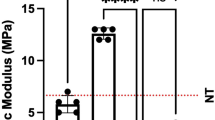Abstract
Introduction and hypothesis
The present study set out to modify polypropylene vaginal surgical material using porcine urinary bladder matrix (UBM) in order to improve biocompatibility. The aim was to develop a compound scaffold that induced less vaginal erosion and to evaluate host immunoreactivity to this material in vivo.
Methods
Forty-eight Sprague–Dawley rats were randomly divided into four equal groups. One group underwent a sham operation, and the other groups underwent vaginal implantation with different materials: UBM (U); UBM + polypropylene (UP); or polypropylene (P). The host tissue response was determined by macro-observation, and by histological and immunohistochemical methods at 7, 14, 21, or 28 days after surgery.
Results
The inflammation reaction was strongest throughout the entire observation time in Group P, but was weaker and had a tendency to decrease with time in Groups U and UP. The presence of the UBM material in the compound scaffold allowed the polypropylene to fuse with newly proliferating surrounding tissue and resulted in less rejection of the material by the host, as indicated by the reduced appearance of CD4-, and CD8-positive cells.
Conclusions
Porcine UBM allowed mechanical isolation of polypropylene, and also reduced the immune reaction to polypropylene. This study suggests that the UBM + polypropylene compound scaffold may be a promising material for clinical use in pelvic reconstruction surgery.



Similar content being viewed by others
References
Chaliha C, Khullar V (2006) Surgical repair of vaginal prolapse: a gynaecological hernia. Int J Surg 4(4):242–250
Altman D, Lopez A, Gustafsson C, Falconer C, Nordenstam J, Zetterstrom J (2005) Anatomical outcome and quality of life following posterior vaginal wall prolapse repair using collagen xenograft. Int Urogynecol J Pelvic Floor Dysfunct 16(4):298–303
Altman D, Vayrynen T, Engh ME, Axelsen S, Falconer C (2011) Anterior colporrhaphy versus transvaginal mesh for pelvic-organ prolapse. N Engl J Med 364(19):1826–1836
Withagen MI, Milani AL, den Boon J, Vervest HA, Vierhout ME (2011) Trocar-guided mesh compared with conventional vaginal repair in recurrent prolapse: a randomized controlled trial. Obstet Gynecol 117(2 Pt 1):242–250
Rzepka J, Brocker K, Alt C, Corteville C, Sohn C, Lenz F (2010) Pelvic organ prolapse: does the postoperative course of mesh-repair surgery differ in elderly women when compared with younger patients. J Obstet Gynaecol 30(8):852–856
Nazemi TM, Kobashi KC (2007) Complications of grafts used in female pelvic floor reconstruction: Mesh erosion and extrusion. Indian J Urol 23(2):153–160
Liang CC, Lin YH, Chang YL, Chang SD (2011) Urodynamic and clinical effects of transvaginal mesh repair for severe cystocele with and without urinary incontinence. Int J Gynaecol Obstet 112(3):182–186
Iglesia CB, Sokol AI, Sokol ER et al (2010) Vaginal mesh for prolapse: a randomized controlled trial. Obstet Gynecol 116(2 Pt 1):293–303
Badylak SF (2004) Xenogeneic extracellular matrix as a scaffold for tissue reconstruction. Transpl Immunol 12(3–4):367–377
Badylak SF (2007) The extracellular matrix as a biologic scaffold material. Biomaterials 28(25):3587–3593
Ge L, Zheng S, Wei H (2009) Comparison of histological structure and biocompatibility between human acellular dermal matrix (ADM) and porcine ADM. Burns 35(1):46–50
Chaliha C, Khalid U, Campagna L, Digesu GA, Ajay B, Khullar V (2006) SIS graft for anterior vaginal wall prolapse repair—a case-controlled study. Int Urogynecol J Pelvic Floor Dysfunct 17(5):492–497
Franklin ME Jr, Gonzalez JJ Jr, Glass JL (2004) Use of porcine small intestinal submucosa as a prosthetic device for laparoscopic repair of hernias in contaminated fields: 2-year follow-up. Hernia 8(3):186–189
Arnold GA, Mathews KG, Roe S, Mente P, Seaboch T (2009) Biomechanical comparison of four soft tissue replacement materials: an in vitro evaluation of single and multilaminate porcine small intestinal submucosa, canine fascia lata, and polypropylene mesh. Vet Surg 38(7):834–844
Liu L, Li D, Wang Y, Xu H, Ge L, Liang Z (2011) Evaluation of the biocompatibility and mechanical properties of xenogeneic (porcine) extracellular matrix (ECM) scaffold for pelvic reconstruction. Int Urogynecol J Pelvic Floor Dysfunct 22:221–227
Jansen RG, van Kuppevelt TH, Daamen WF, Kuijpers-Jagtman AM, Von den Hoff JW (2008) Tissue reactions to collagen scaffolds in the oral mucosa and skin of rats: environmental and mechanical factors. Arch Oral Biol 53(4):376–387
Elmer C, Blomgren B, Falconer C, Zhang A, Altman D (2009) Histological inflammatory response to transvaginal polypropylene mesh for pelvic reconstructive surgery. J Urol 181(3):1189–1195
Huffaker RK, Muir TW, Rao A, Baumann SS, Kuehl TJ, Pierce LM (2008) Histologic response of porcine collagen-coated and uncoated polypropylene grafts in a rabbit vagina model. Am J Obstet Gynecol 198(5):582.e1–582.e7
Bayrak A, Tyralla M, Ladhoff J et al (2010) Human immune responses to porcine xenogeneic matrices and their extracellular matrix constituents in vitro. Biomaterials 31(14):3793–3803
Yang M, Liu L (2008) MHC II gene knockout in tissue engineering may prevent immune rejection of transplants. Med Hypotheses 70(4):798–801
Brown RA, Phillips JB (2007) Cell responses to biomimetic protein scaffolds used in tissue repair and engineering. Int Rev Cytol 262:75–150
Schutte RJ, Xie L, Klitzman B, Reichert WM (2009) In vivo cytokine-associated responses to biomaterials. Biomaterials 30(2):160–168
Mallapragada SK, Narasimhan B (2008) Immunomodulatory biomaterials. Int J Pharm 364(2):265–271
Badylak SF, Gilbert TW (2008) Immune response to biologic scaffold materials. Semin Immunol 20(2):109–116
Funding
This work was supported by a grant from the National Natural Science Foundation of China (No. 30870621)
Conflicts of interest
None.
Author information
Authors and Affiliations
Corresponding author
Rights and permissions
About this article
Cite this article
Liu, L., Deng, L., Wang, Y. et al. Porcine urinary bladder matrix-polypropylene mesh: a novel scaffold material reduces immunorejection in rat pelvic surgery. Int Urogynecol J 23, 1271–1278 (2012). https://doi.org/10.1007/s00192-012-1745-8
Received:
Accepted:
Published:
Issue Date:
DOI: https://doi.org/10.1007/s00192-012-1745-8




